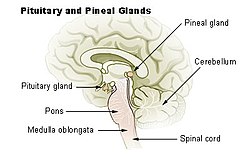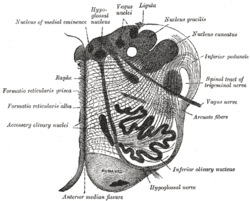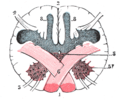Medulla oblongata
| Medulla oblongata | |
|---|---|
 Medulla oblongata labeled at bottom left | |
 Section of the medulla oblongata at about the middle of the olive. | |
| Details | |
| Part of | Brain stem |
| Identifiers | |
| Latin | medulla oblongata |
| MeSH | D008526 |
| NeuroNames | 698 |
| NeuroLex ID | birnlex_957 |
| TA98 | A14.1.03.003 |
| TA2 | 5983 |
| FMA | 62004 |
| Anatomical terms of neuroanatomy | |
The medulla oblongata is the lower portion of the brainstem. It deals with autonomic functions.
Location
By anatomical terms of location, it is rostral to the spinal cord and caudal to the pons, which is in turn ventral to the cerebellum.
For a human or other bipedal species, this means it is above the spinal cord, below the pons, and anterior to the cerebellum.
Anatomy
Two parts: open and closed
The medulla is often thought of as being in two parts:
- an open part (close to the pons)
- a closed part (further down towards the spinal cord).
The opening referred to is on the dorsal side of the medulla, and forms part of the fourth ventricle of the brain.
Landmark fissures and sulci
The medulla has an anterior median fissure and a posterior median sulcus corresponding to the structures seen in the spinal cord.
On each side, the anterolateral sulcus lies in line with the ventral roots of the spinal nerves. The rootlets of cranial nerve XII (the hypoglossal nerve) emerge from this sulcus.
The posterolateral sulcus lies in line with the dorsal roots of the spinal nerves. It gives attachment to the rootlets of the glossopharyngeal, vagus and the accessory nerve or the IX, X, and the XI cranial nerves from above downward in order.
Between the anterior median sulcus and the anterolateral sulcus
The region between the anterior median sulcus and the anterolateral sulcus is occupied by an elevation on either side called as the pyramid of medulla oblongata. This elevation is caused by the corticospinal tract.
In the lower part of the medulla some of these fibers cross each other thus obliterating the anterior median fissure. This is known as the decussation of the pyramids.
Some other fibers that originate from the anterior median fissure above the decussation of the pyramids and run laterally across the surface of the pons are known as the external arcuate fibers.
Between the anterolateral and posterolateral sulci
The region between the anterolateral and posterolateral sulci in the upper part of the medulla is marked by a swelling known as the olive.
It is caused by a large mass of gray matter known as the inferior olivary nucleus.
Between the posterior median sulcus and the posterolateral sulcus
The posterior part of the medulla between the posterior median sulcus and the posterolateral sulcus contains tracts that enter it from the posterior funiculus of the spinal cord. These are the fasciculus gracilis, lying medially next to the midline, and the fasciculus cuneatus, lying laterally.
These fasciculi end in rounded elevations known as the gracile and the cuneate tubercles. They are caused by masses of gray matter known as the nucleus gracilis and the nucleus cuneatus.
Just above the tubercles, the posterior aspect of the medulla is occupied by a triangular fossa, which forms the lower part of the floor of the fourth ventricle. The fossa is bounded on either side by the inferior cerebellar peduncle, which connects the medulla to the cerebellum.
Lower part
The lower part of the medulla, immediately lateral to the fasciculus cuneatus, is marked by another longitudinal elevation known as the tuberculum cinereum.
It is caused by an underlying collection of gray matter known as the spinal nucleus of the trigeminal nerve.
The gray matter of this nucleus is covered by a layer of nerve fibers that form the spinal tract of the trigeminal nerve.
Base
The base of the medulla is defined by the commissural fibers, crossing over from the ipsilateral side in the spinal cord to the contralateral side in the brain stem; below this is the spinal cord.
Functions
The medulla oblongata controls autonomic functions, and relays nerve signals between the brain and spinal cord. It is also responsible for controlling several major points and autonomic functions of the body:
- respiration (via dorsal respiratory group and ventral respiratory group)
- blood pressure
- heart rate
- reflex arcs
- vomiting
- defecation
Blood supply
Blood to the medulla is supplied by a number of arteries.
- Anterior spinal artery: The anterior spinal artery supplies the whole medial part of the medulla oblongata. A blockage (such as in a stroke) will injure the pyramidal tract, medial lemniscus, and the hypoglossal nucleus. This causes a syndrome called medial medullary syndrome.
- Posterior inferior cerebellar artery (PICA): The posterior inferior cerebellar artery, a major branch of the vertebral artery, supplies the posterolateral part of the medulla, where the main sensory tracts run and synapse. (As the name implies, it also supplies some of the cerebellum.)
- Direct branches of the vertebral artery: The vertebral artery supplies an area between the other two main arteries, including the nucleus solitarius and other sensory nuclei and fibers. Lateral medullary syndrome can be caused by occlusion of either the PICA or the vertebral arteries.
- (ceribellar artery is suppelyed by the medulla)
Additional images
-
Beginning of medulla oblongata in the human brain
-
Lobes
-
Scheme showing the connections of the several parts of the brain.
-
Anteroinferior view of the medulla oblongata and pons.
-
Section of the medulla oblongata through the lower part of the decussation of the pyramids
-
Section of the medulla oblongata at the level of the decussation of the pyramids.
-
Transverse section of medulla oblongata below the middle of the olive.
-
The formatio reticularis of the medulla oblongata, shown by a transverse section passing through the middle of the olive.
-
Transverse section passing through the sensory decussation.
-
Mesal aspect of a brain sectioned in the median sagittal plane.
-
Base of brain.
-
Diagram showing the positions of the three principal subarachnoid cisternæ.
Popular Culture
- In the movie Fight Club, the unnamed main character reads a series of articles, written by the previous owner of the derelict house he and Tyler Durden now occupy, which are written from the first-person perspective of various human bodily organs. One such article reads "I am Jack's medulla oblongata. Without me, Jack could not regulate his heart rate, blood pressure, or breathing."
- In The Waterboy, when asked why alligators are so aggressive, Adam Sandler's character responds "My Mama says that alligators are ornery because they got all them teeth and no toothbrush." Professor Colonel Sanders then informs him that aggressive behavior in alligators is caused by an enlarged Medulla oblongata.
- In Futurama, in the episode 'Parasites lost', the worms leave Fry's body, after he threatens to sever the Medulla Oblongata, which would cause his death. The worms leave, but leave after Fry had done severs damage to his brain already.











